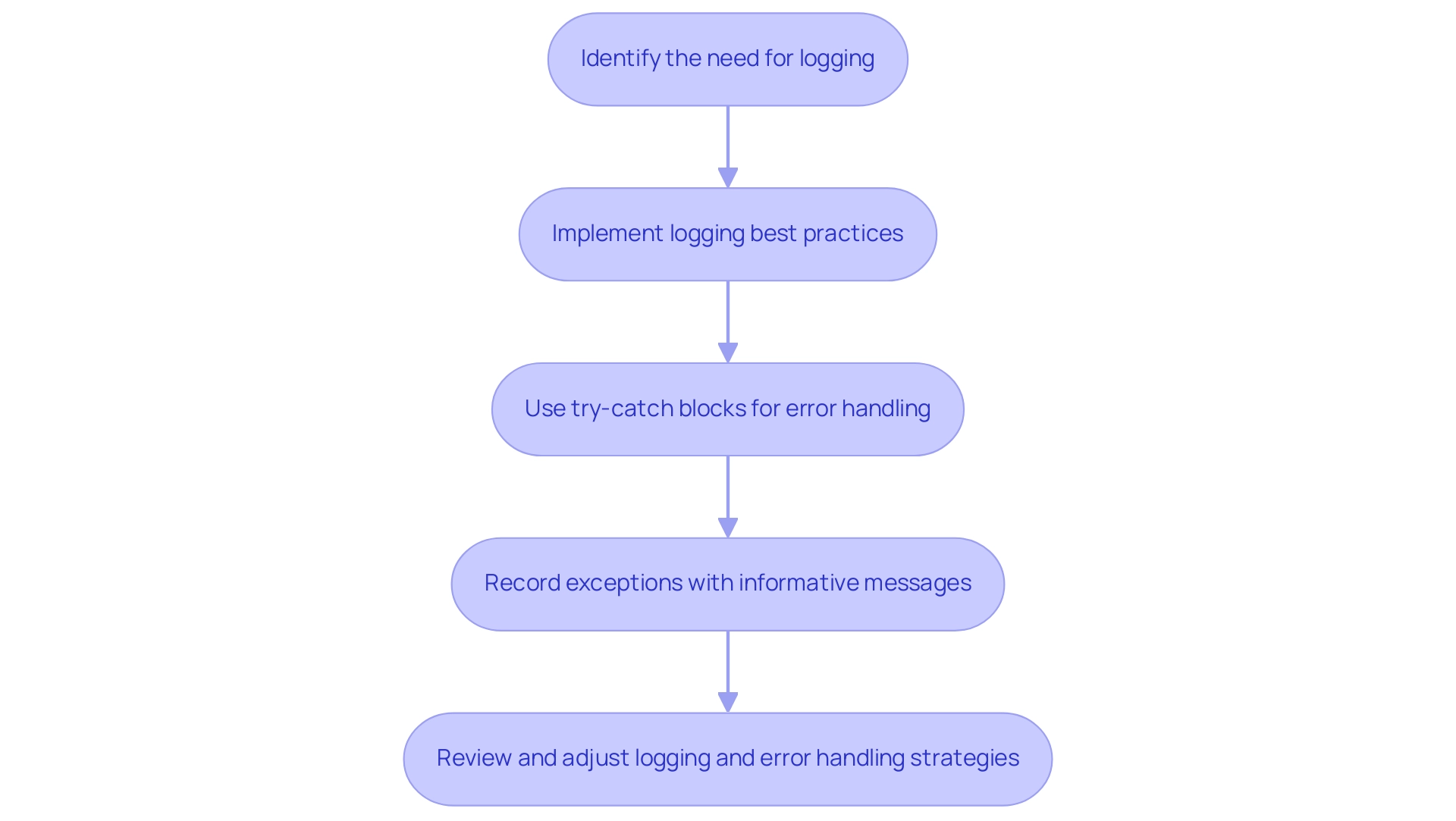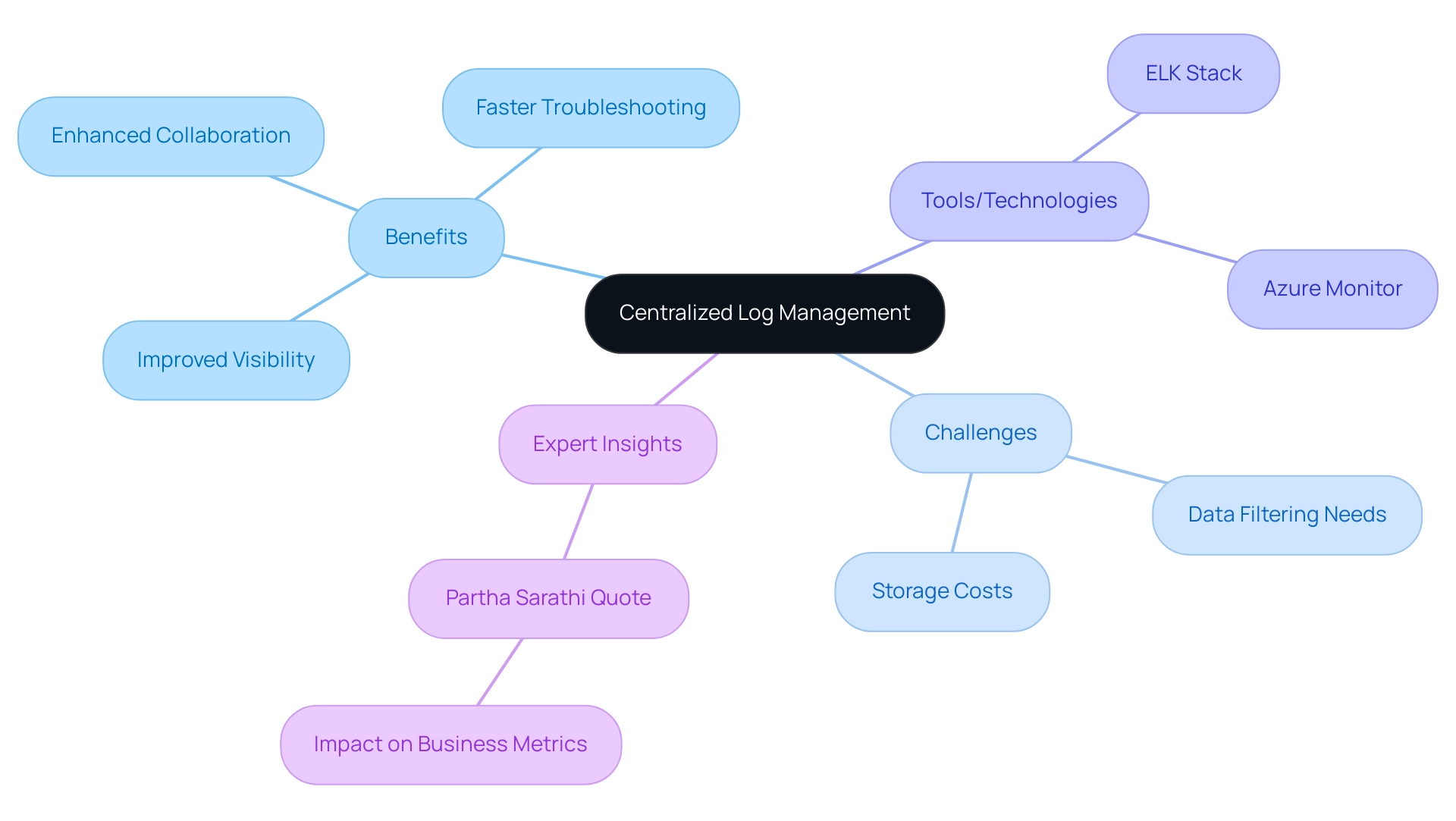Overview
The article focuses on best practices for logging in C#, emphasizing the importance of effective logging and error handling for optimal software performance. It outlines various strategies, such as structured logging, the use of appropriate tools like NLog and Serilog, and centralized log management, all of which enhance visibility and facilitate faster issue resolution, thereby improving overall application reliability and user experience.
Introduction
In the realm of C# development, the significance of logging and error handling cannot be overstated. As applications grow in complexity, the ability to track behavior and manage exceptions becomes paramount for ensuring a seamless user experience.
Effective logging not only provides developers with essential insights into application performance but also serves as a safeguard against potential crashes and data loss. By adopting robust error handling practices and leveraging advanced logging techniques, development teams can enhance application reliability and streamline troubleshooting processes.
This article delves into the critical aspects of logging, from selecting the right tools to implementing structured logging and advanced techniques, all aimed at maximizing efficiency and elevating the quality of software development.
The Critical Role of Logging and Error Handling in C# Development
In C# development, implementing effective record-keeping and error management is not only advantageous; it’s crucial for achieving optimal software performance. Logging best practices in C# serve as an essential instrument for monitoring software behavior and swiftly identifying problems, providing programmers with crucial insights into the system's condition and user interactions. Moreover, robust error handling strategies ensure that exceptions are managed gracefully, which prevents crashes and data loss that could severely affect user experience.
For instance, utilizing try-catch blocks effectively allows developers to capture exceptions, and recording these exceptions with detailed, informative messages can significantly expedite the troubleshooting process. This proactive approach not only saves time and resources but also enhances the overall reliability of the application through the implementation of logging best practices C#. A clear reminder of the consequences of neglecting error handling is illustrated by the fact that it took 15 years for anyone to notice errors in the BLOSUM62 amino acid substitution matrix used for protein sequence alignment, emphasizing the long-term implications of insufficient record-keeping practices.
Recent trends indicate that as software continues to integrate deeper into daily life, particularly in the realm of IoT development, the significance of logging best practices C# and thorough documentation practices is more pronounced than ever. As David Soergel aptly noted, 'Thanks very much for your insightful comments, and apologies for the long-delayed response,' emphasizing the need for timely and effective record-keeping. By referencing the case study by Zhou and Leung (2006), which demonstrated how categorizing errors by severity can improve testing focus and resource allocation, it becomes evident that prioritizing record-keeping from the outset allows development teams to identify and rectify issues early, ensuring a seamless user experience and maintaining software integrity.

Choosing the Right Tools for Effective Logging in C#
Choosing the appropriate tools in C# is essential for adhering to logging best practices C# that improve both log quality and application performance. Libraries such as NLog and Serilog are notable for their strong features designed for various tracking needs. Serilog excels with its structured record-keeping capabilities, which facilitate enriched log data that can be queried effortlessly—ideal for extracting insights from logs.
On the other hand, NLog offers unparalleled flexibility in configuring targets and layouts, making it a versatile choice for developers. Notably, Log4net's configuration permits output to both console and file appenders, further illustrating the breadth of options available in the recording ecosystem. When selecting a framework for tracking, it is essential to evaluate your application's specific needs, including performance, scalability, and ease of integration, while also considering logging best practices C#.
Furthermore, community assistance and comprehensive documentation, as well as logging best practices C#, can significantly ease the implementation process, guaranteeing that programmers can optimize the efficiency of their tracking strategy. As Robert Koritnik points out, while many have depended on Enterprise Library, a significant shift towards alternative products like NLog and Serilog is becoming apparent among programmers today, emphasizing the importance of these tools. Furthermore, Log Owl acts as a contemporary case study in error tracking, emphasizing a self-hosted and privacy-focused approach that attracts privacy-aware programmers, thereby enhancing the conversation on current tracking solutions.
Implementing Structured Logging for Enhanced Clarity
Structured data recording stands as a transformative technique that empowers developers to capture information in a consistent and easily queryable format. This method substitutes conventional plain text record-keeping with structured objects, enabling more efficient searching and filtering of log entries. Log data can be organized into key-value pairs, making it easier to search, filter, and analyze.
For instance, using JSON for records enables smooth integration with robust monitoring tools like the ELK Stack and Splunk. To effectively implement structured tracking in C#, developers should follow logging best practices C# by leveraging libraries like Serilog, which natively support structured data. By embedding contextual information—such as user IDs or transaction IDs—directly into log entries, the clarity of logs is significantly enhanced.
As Nicholas Blumhardt aptly notes,
This structured data goes to Kibana. The value 1234 is stored in the Order Id field of the log entry.
Moreover, case studies such as New Relic's illustrate how logging best practices C# improve log management by enabling users to add custom attributes and conduct powerful searches, ultimately enhancing system health and performance.
This practice not only simplifies issue diagnosis but also aids in comprehensive software performance analysis, leading to better quality and increased developer engagement.
Centralizing Log Management for Better Oversight
Centralizing record management is essential for attaining thorough visibility of system records, especially within intricate frameworks consisting of multiple elements. Solutions such as the ELK Stack (Elasticsearch, Logstash, Kibana) and Azure Monitor facilitate the aggregation of logs from diverse sources into a unified location, enhancing accessibility and analysis. This centralized approach allows developers to swiftly identify issues across multiple services and applications, significantly reducing troubleshooting time.
Furthermore, it encourages collaboration among team members by providing a collective view of log data, simplifying incident tracking and performance metric monitoring across the entire system. As organizations increasingly acknowledge the importance of their log data quality, investments in centralized recording solutions are anticipated to grow, propelled by the necessity for efficient data management and enhanced operational outcomes. Centralized log management is linked to financial outcomes by ensuring platform availability and reducing threat actor presence.
Notably, Splunk operates in 21 regions around the world, underscoring the global significance of effective log management solutions. Partha Sarathi, Director of Engineering, emphasizes, 'I know that we are able to impact our key business metrics in a positive way with Statsig. We are definitely heading in the right direction with Statsig.'
However, despite its advantages, centralized record-keeping faces challenges such as the need to filter out irrelevant data and the potential for increased storage costs due to noisy log data. Implementing log filtering techniques and organizing log data following logging best practices in C# can mitigate these challenges, ensuring efficient and cost-effective log management.

Advanced Logging Techniques: Custom Exceptions and Correlation IDs
Implementing logging best practices C# significantly elevates the effectiveness of your logging strategy. Custom exception classes enable programmers to categorize and manage errors with precision, offering deeper insights into the specific challenges faced during development. As noted by the expert blog,
Why catch an exception, to just rewrap it in another exception?
This highlights the necessity of thoughtful error handling. Furthermore, the integration of correlation IDs is invaluable, particularly in microservices architectures. By assigning a unique correlation ID to each request, developers can seamlessly trace the request flow across various services, simplifying the debugging process.
This approach not only enhances log clarity but also enables teams to tackle issues with greater speed and efficiency. Notably, this article has been viewed 92,000 times, underscoring the popularity and relevance of these advanced record-keeping techniques. The use of centralized tracking frameworks further reinforces consistent practices across applications, facilitating maintenance and troubleshooting.
Furthermore, the requirement of Abstract Base Classes (ABCs) in Python mirrors the wider concepts of error management and tracking that can be utilized across various programming languages. A pertinent case study titled 'Logging Exceptions' highlights the significance of logging best practices C# by recording exception details, including messages and stack traces, which is essential for debugging and analysis. Utilizing a centralized tracking framework enables uniform record-keeping practices throughout the application, assisting in maintenance and troubleshooting.
With these advanced techniques, developers can optimize their error handling and follow logging best practices C# in their logging processes, ultimately driving productivity and operational success.
Conclusion
Effective logging and error handling are fundamental pillars for successful C# development, ensuring applications not only perform optimally but also provide a seamless user experience. The implementation of robust logging strategies enables developers to gain critical insights into application behavior, while advanced error handling practices prevent crashes and data loss. By selecting the right tools, such as NLog and Serilog, and adopting structured logging techniques, development teams can significantly enhance their ability to diagnose issues efficiently and maintain application reliability.
Centralizing log management further amplifies these benefits, allowing for comprehensive visibility across complex systems. Tools like the ELK Stack and Azure Monitor streamline the aggregation of logs, fostering collaboration and expediting troubleshooting processes. As organizations increasingly recognize the value of their log data, investing in centralized solutions becomes paramount for effective data management and improved operational outcomes.
Ultimately, embracing advanced logging techniques such as custom exceptions and correlation IDs empowers developers to refine their error handling strategies. By optimizing these practices, teams can elevate application quality, drive productivity, and ensure a resilient software environment. The commitment to effective logging and error handling is not merely a technical necessity; it is a strategic advantage that can significantly impact the success and reliability of any software application.
Frequently Asked Questions
Why is effective record-keeping and error management important in C# development?
Effective record-keeping and error management are crucial for achieving optimal software performance, as they allow for monitoring software behavior, swiftly identifying problems, and ensuring a seamless user experience.
What are logging best practices in C#?
Logging best practices in C# involve monitoring software behavior and providing insights into the system's condition and user interactions, which can help in troubleshooting issues efficiently.
How can try-catch blocks be utilized in error handling?
Try-catch blocks can be effectively used to capture exceptions, and recording these exceptions with detailed messages can significantly expedite the troubleshooting process.
What are the consequences of neglecting error handling?
Neglecting error handling can lead to crashes and data loss, severely affecting user experience. An example is the 15-year delay in noticing errors in the BLOSUM62 amino acid substitution matrix.
How does the integration of software into daily life affect logging practices?
As software becomes more integrated into daily life, particularly in IoT development, the significance of logging best practices and thorough documentation becomes more pronounced.
What tools are recommended for logging in C#?
Recommended tools for logging in C# include NLog, Serilog, and Log4net. NLog offers flexibility, Serilog excels in structured record-keeping, and Log4net allows output to both console and file appenders.
What should developers consider when selecting a logging framework?
Developers should evaluate their application's specific needs, including performance, scalability, and ease of integration, while adhering to logging best practices.
How can community support and documentation aid in implementing logging practices?
Community assistance and comprehensive documentation can ease the implementation process, helping programmers optimize the efficiency of their logging strategies.
What is the trend regarding the use of logging tools among programmers?
There is a notable shift among programmers towards using alternative logging products like NLog and Serilog, moving away from traditional tools like Enterprise Library.
What is Log Owl and its significance in error tracking?
Log Owl is a contemporary case study in error tracking that emphasizes a self-hosted and privacy-focused approach, appealing to privacy-aware programmers and enhancing discussions on current tracking solutions.




